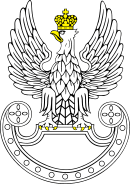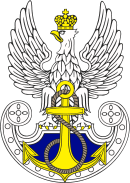Operation Ostra Brama
Operation Ostra Brama (lit. Operation Sharp Gate, English: Operation Gate of Dawn) was an armed conflict during World War II between the Polish Home Army and the Nazi German occupiers of Vilnius (Polish: Wilno). It began on 7 July 1944, as part of a Polish national uprising, Operation Tempest, and lasted until 14 July 1944. Though the Germans were defeated, the following day the Soviet Red Army entered the city and the Soviet NKVD interned Polish soldiers and arrested their officers. Several days later, the remains of the Polish Home Army retreated into the forests, and the Soviets were in control of the city.
| Operation Ostra Brama | ||||||||
|---|---|---|---|---|---|---|---|---|
| Part of Operation Tempest in the Eastern Front of World War II | ||||||||
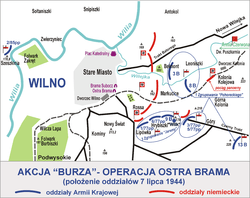 Dislocation of Polish and German units at the start of the fighting. | ||||||||
| ||||||||
| Belligerents | ||||||||
|
|
|
| ||||||
| Commanders and leaders | ||||||||
|
Aleksander Krzyżanowski Antoni Olechnowicz Czesław Dębicki | Rainer Stahel | Ivan Chernyakhovsky | ||||||
| Strength | ||||||||
| 4,200 | 7,700 | 100,000 | ||||||
| Casualties and losses | ||||||||
| ~500 | Unknown | |||||||
| Part of a series on the |
Underground State |
|---|
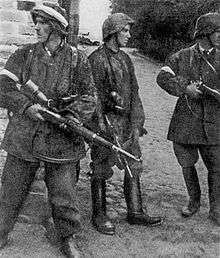 |
|
Authorities
|
|
Political organizations Major parties Minor parties
Opposition
|
|
Military organizations Home Army (AK) Mostly integrated with Armed Resistance and Home Army Partially integrated with Armed Resistance and Home Army
Non-integrated but recognizing authority of Armed Resistance and Home Army Opposition |
|
Related topics |
From the Polish point of view, while the German defeat constituted a Polish tactical victory, the ensuing destruction of the Polish units by the Soviets resulted in a strategic defeat, especially considering the goals of Operation Tempest. From the Soviet point of view, the operation was a complete success, as both the Germans and the Poles loyal to the London government suffered a defeat.
The main reason for the operation was for propaganda purposes – to claim full rights to Vilnius by retaking it before the Soviet Army arrived to reinforce the Polish Army.[1]
Assumptions
Operation 'Ostra Brama' was meant to be carried out during an expected state of confusion among German units in Vilnius (Wilno), who would be in fear of the impending arrival of overwhelming Soviet forces. Since the Polish command did not anticipate successfully taking the city with Kraków Army forces alone, as the Germans held strong positions in the fortified city, the plan for capturing Vilnius resembled plans for the Warsaw Uprising. The Polish and Soviet armies would take enemy outposts around the city, expecting the Germans to quickly retreat in the face of overwhelming forces.
Plans for uprising
On 12 June 1944 General Tadeusz Bór-Komorowski, Commander-in-Chief of the Home Army, issued an order to prepare a plan of liberating Vilnius from German hands. The Home Army districts of Vilnius and Navahrudak planned to take control of the city before the Soviets could reach it. The Commander of the Home Army District in Vilnius, lieutenant colonel Aleksander "Wilk" Krzyżanowski, decided to regroup all the partisan units in the northeastern part of Poland for the assault, both from inside and outside of the city.
On 26 June 1944 major Teodor "Slaw" Cetys and lieutenant colonel Zygmunt "Strychański" Blumski suggested a plan to Wilk. 'Ostra Brama order number 1' comprised an overall outline for an assault on Vilnius, where the Home Army forces of the combined districts Vilnius and Navahrudak would strike from the outside under the lead of lieutenant colonel Poleszczuk.
The Polish forces were organized into five groups:
- Combat Group 1 'East' - included the 3rd, 8th and 13th Brigade; the 3rd and 5th Battalion of the 3rd and 5th Infantry Regiment; ORKO "Groma" and OS "Wilczura" under major Antoni "Pohorecki" Olechnowicz
- Combat Group 2 'North' - Under the command of major "Węgielny"
- Combat Group 3 'Eastern South'- Under the command of "Jarema" contained the 9th Brigade, the 1st and 6th Battalions of the 77th Infantry Regiment, OD "Promienia" and OS "Gracza"
- Combat Group 4 'South' - Under the command of major Stanisław "Warta" Sędziak
- Combat Group 5 'West' - Under the command of cavalry master (rotmistrz) Zygmunt "Łupaszka" Szendzielarz.
Units inside the city were under the command of lieutenant colonel "Ludwik".
According to the plan, the main attack was prepared from the east and southeast on 8 July. When the second Red Army crossed the front, equivalent to where it was in 1916 (between Soly and Smarhon’), the uprising would begin.
Combat operations
7 July 1944
On 7 July, at dawn (one day earlier than it had been originally scheduled) Wilk made the decision to launch operations early as the Soviet Army was already approaching the city. As a result of this change, only one of the three designated battalions managed to get in position (the line between the cemetery at Rosa and Bielmont was designated as the line of attack) when the battle began. In spite of the incomplete mobilization, around 4,000 Polish soldiers, supported by two anti-tank guns and a few mortars attacked Germans' lines. The Polish Army had to fight against German forces (who were heavily armored, several times stronger and well protected) which had tanks, anti-tanks, strong artillery and air cover provided from a nearby airfield in Porubanek at their disposal. In the meantime, a few hundred Polish Army soldiers engaged in actions inside the city, primarily from the district "A"-Kalwaryjska, but most of the units failed to mobilize on time and did not take part in the fighting.
After bitter fighting, the 3rd and 5th Battalions from Combat Group 1 captured Góry and neutralized an armored train in the vicinity of Kolonia Wileńska, but they could not proceed under heavy fire.
At mid-day, the first units of the Red Army (the 3rd Mechanized Corps) finally appeared on the battlefield. The first contacts with Soviet units took place when Combat Group 1 met with their eastern ally. The commander of the Soviet 35th Tank Brigade insisted on taking command of Combat Group 1. Pohorecki, without Polish Army approval, joined his forces under Soviet command; Wilk responded by immediately replacing Pohorecki with major Antoni Wasilewski "Olesiński", but it took the 8th Brigade several days to return to reconstitute.
Simultaneously, Combat Group 3, having not yet made a reconnaissance of German defenses, pushed forward. The 1st and 6th battalions reached the first line of fortifications on the boundary of the village of Lipówka and crossed the Vilnius-Pabradė railroad tracks. They were soon repulsed to their initial positions by a German counterattack, which pinned down the 9th Brigade at blockhouses in Hrybiszek.
The 3rd Brigade of Combat Group 1 achieved the greatest success. After crossing Wileńka, they reached Zarzecze and Trakt Batorego, remaining in their positions until 8 July before taking up the offensive again, joining the approaching Soviet units. However, having incurred heavy losses under bombardment from air and artillery, they had to withdraw to Szwajcar.
8–9 July 1944
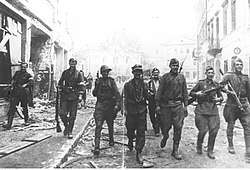
The main forces arrived on 8 July, amounting to 100,000 soldiers in total with the aid of few hundred tanks and air support. Jan started to fight Germans side-by-side with the Soviet 97th of Witebsk Infantry Division. In a charge at the hill Szeszkinie they were able to capture two enemies tanks. The 2nd Battalion of 85th Infantry Regiment under Jan operated in Kalwaryjska and succeeded in bringing the district under control.
A fierce fight that unleashed on the streets between the Nazis and the combined forces of the Red Army and the Home Army lasted for a few days.
10 July 1944
On 10 July, the Polish Army started to achieve its first successes. The 2nd Polish Battalion crossed the Wilia River and engaged in operations inside the city. The 1st Company of that Battalion were led by lieutenant Wacław Pietkiewicz "Mocny" to assault positions on streets Zamkowa and Wielka, and these experienced particular heavy fighting by the Orthodox Church. The 2nd Company, under orders of lieutenant Wacław Korzeniowski "Andrzej", fought at the foot of the hill Zamkowa, at streets Święta Anna, Sofianka, Baszta. The balance of assault titled in favor of Polish troops when German soldiers defending communication bunker surrendered it to the Polish. In the meantime, the 3rd Company of lieutenant Wacław Roszkowski "Biały" supported by Soviet tanks were assaulting at Mostowa Street, and then Zygmuntowska, Wileńska and Hills of Zakręt. The units in the center of city did not follow the way of other companies, as their failed to seize strategic points in the 'Sródmieście' (city center) of Vilnius.
11–13 July 1944
The Germans fought house-to-house until they eventually arrived at the conclusion that their position had weakened so badly that they no longer can hold the city. As a result, 3,000 soldiers under Generalleutnant Reiner Stahel evaded the besiegers under the cover of darkness overnight on 13 July. However, they met Polish Army soldiers under Major "Węgielny", and in a desperate stand at Krawczuny (modern Kriaučiūnai, a western suburb of Vilnius near today's eldership of Pilaitė), they were badly beaten (though Stahel escaped capture and reached Warsaw a few days later). By 13 July, Vilnius was in the hands of Polish and Soviet soldiers.
Epilogue
When the battle was over, the Soviet Command demanded the immediate abandonment of Vilnius by Polish soldiers. The Polish commander, Colonel Krzyżanowski (Wilk) ordered Polish units to set off for the Puszcza Rudnicka, while he set off for the headquarters of General Czerniachowski, commander of the 3rd Belorussian Front. Krzyżanowski was promised by the Soviets that the Polish would be supplied with equipment without any political conditions. On 16 July, Krzyżanowski was once again invited to the headquarters of Czerniachowski to sign an agreement. However, this time, the Soviets arrested Krzyżanowski and his Chief of Staff, Major Teodor Cetys, as well as other Polish representatives at the same time in Bogusze. The wave of arrests also included the delegates of Polish Government in London.
The replacement commander of the Vilnius district, Lieutenant Colonel Zygmunt Izydor Blumski, and commander of the Navahrudak district, Lieutenant Colonel Janusz Prawdzic Szlaski, moved their units into the Forest of Rudnicka under constant fire from Soviet aircraft. Those Polish Army that successfully reached the forests were commanded to make their way to Grodno, Białystok, or to disperse into the local terrain. The Soviets eagerly carried out the hunt for the soldiers of their still official ally, capturing over 5,700 Polish soldiers. Common soldiers were detained in Varniai (Polish Miedniki), whereas officers were sent to Ryazan.
A few decided to join the 1st Polish Army under General Zygmunt Berling, while the majority were forcibly enlisted into the Soviet Red Army. However, those who refused to swear allegiance to the Soviet State were deported to Kaluga, in western Russia. There, they became part of the prisoner slave labor system, widespread in the Soviet Union at the end of the war, until their general release in 1947.
Stripped of their officers and confused, by 18 July, roughly 6,000 soldiers and over 5,000 volunteers had withdrawn to the forests around Vilnius. They were gradually encircled and captured by the Soviets.
None of what happened in Vilnius was disclosed to the general public in the West. Indeed, British media censored stories about these Soviet actions by decree of Minister of Information Brendan Bracken. The wartime allies of the Soviet Union, Great Britain and the United States, were not interested in revealing any news that would contradict with the general impression that the Soviet Union was a liberator of Europe from Nazi evil. Poland had already lost its eastern territories to Stalin at the Tehran Conference, but none of the Polish soldiers fighting in the Battle of Vilnius knew about it.[2]
References
- Tarka, Krzysztof (2000). Jeden z wyklętych - generał Aleksander Krzyżanowski "Wilk" : komendant Okręgu Wileńskiego ZWZ-AK. Warsaw: Oficyna Wydawnicza Rytm. ISBN 83-87893-70-6.
- (in English) Tadeusz Piotrowski (1997). Poland's Holocaust. McFarland & Company. p. 99. ISBN 0-7864-0371-3.
Wilno 1944.
Further reading
- Roman Korab-Żebryk: Operacja wileńska AK. Państwowe Wydawnictwo Naukowe, 1985. ISBN 83-01-04946-4
- Home Army (pol. Armia Krajowa) suppression by NKVD/NKGB operations, in and around Wilno (Vilnius):
- July 6, 1944 Report
- July 17, 1944 Report
- July 18, 1944 Report
- July 20, 1944 Report

